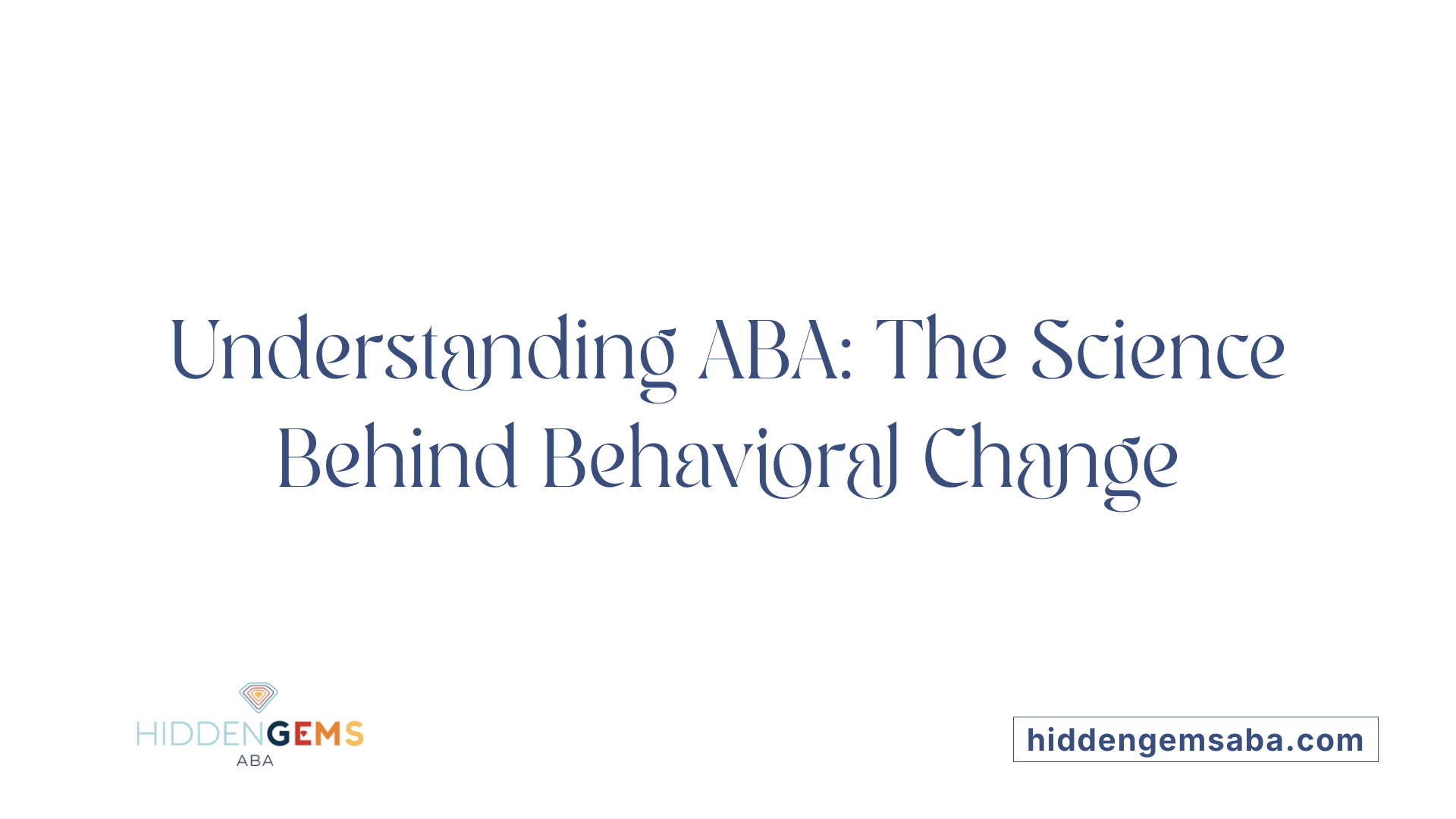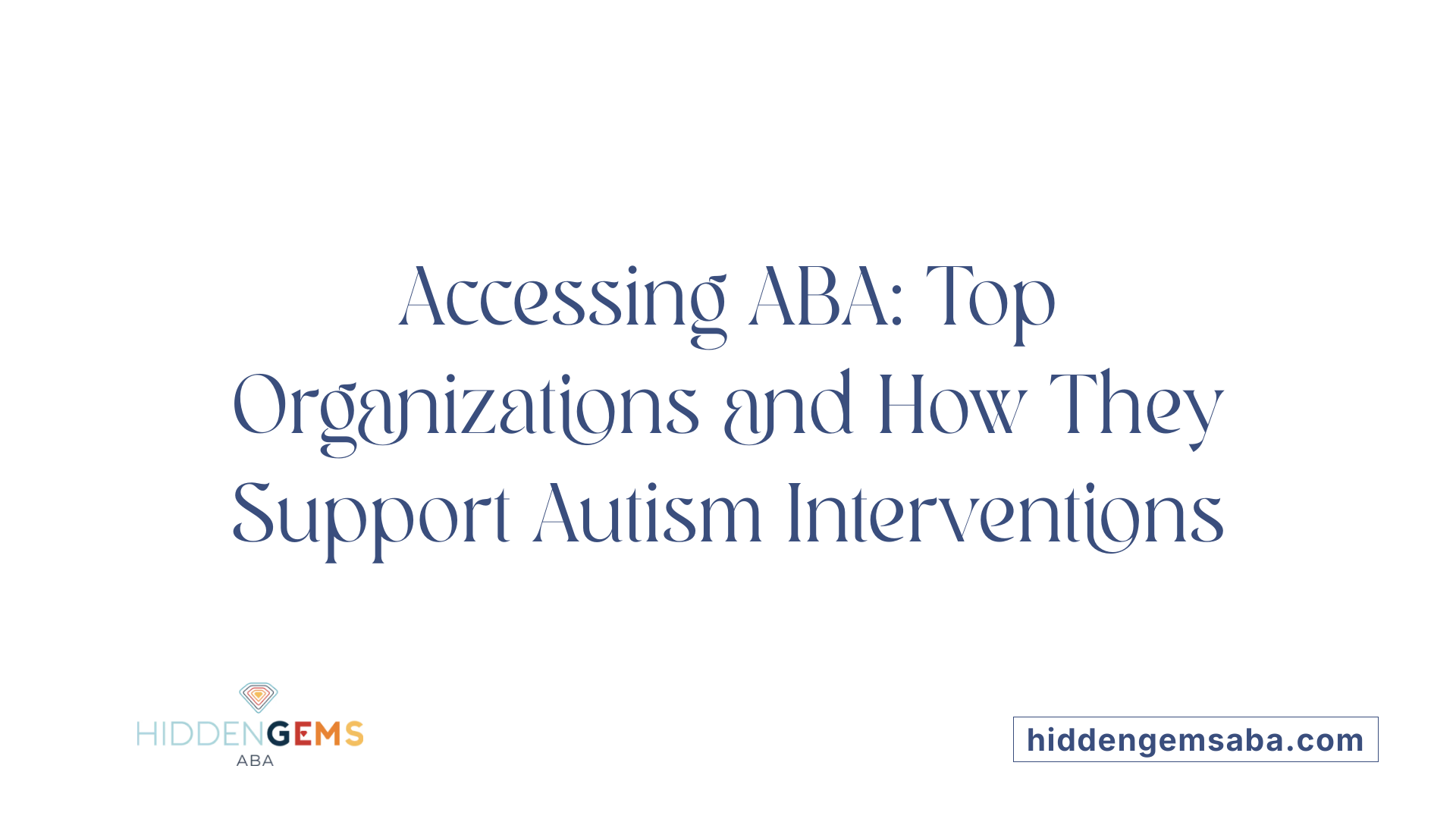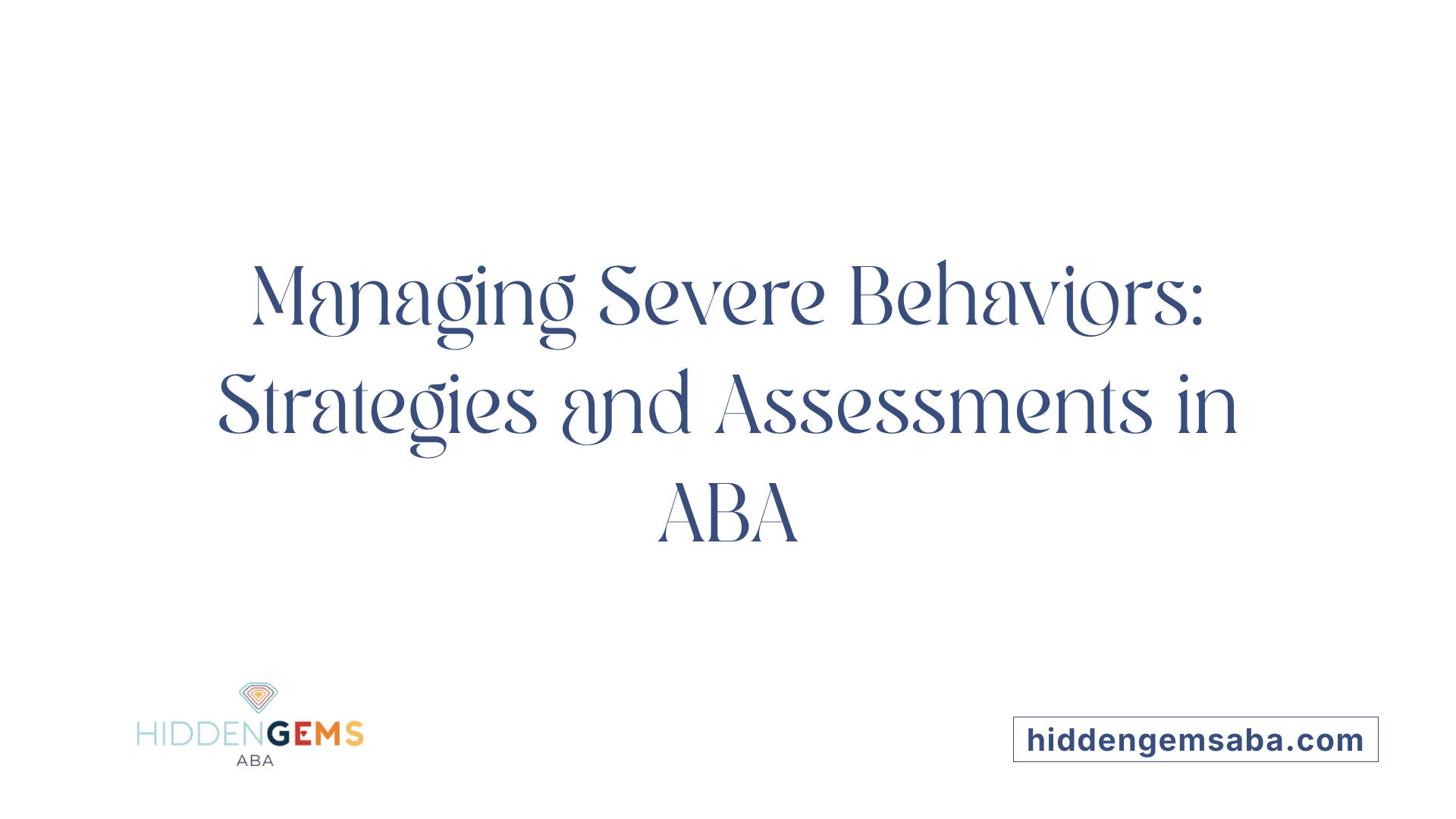Understanding the Challenge of Severe Behaviors in Autism
Severe behavior problems can significantly impact the lives of individuals with autism spectrum disorder (ASD) and their families. Behaviors such as aggression, self-injury, and meltdowns create barriers to learning, social interaction, and safety. Specialized interventions, particularly those grounded in Applied Behavior Analysis (ABA), offer hope by targeting these behaviors with scientifically supported methods. This article explores the principles, professionals, programs, and evidence behind ABA therapy as a cornerstone in managing severe behaviors in autism.
What is Applied Behavior Analysis (ABA) Therapy?

Definition of ABA therapy
Applied Behavior Analysis (ABA) is a therapy grounded in the science of learning and behavior. It focuses on increasing helpful behaviors and reducing harmful or challenging ones. ABA is widely used to support individuals with autism spectrum disorder (ASD) through evidence-based strategies tailored to their unique needs.
Core principles of behavioral analysis
At its core, ABA examines what happens before a behavior (antecedents), the behavior itself, and what happens afterward (consequences). This helps uncover the reasons behind certain behaviors and informs the design of effective interventions. Positive reinforcement, where desirable behaviors are rewarded to encourage repetition, is a central technique.
How ABA helps individuals with autism
ABA therapy aids individuals with autism by improving a broad range of skills, including language and communication, attention, social interaction, memory, and academic abilities. It also helps decrease problem behaviors by teaching alternative, more appropriate ways to communicate or respond to situations, enhancing overall independence and quality of life.
Techniques used such as positive reinforcement and behavior assessment
ABA relies on assessments like the Functional Behavior Assessment (FBA) to identify the purpose of behaviors. Therapists break down learning goals into small, manageable steps and use methods such as discrete trial training, natural environment teaching, and functional communication training. Data is collected regularly to monitor progress and adjust treatment plans accordingly.
Settings and adaptability of ABA therapy
ABA is highly adaptable, delivered in various settings including homes, schools, and community environments. It is typically provided by trained therapists supervised by certified behavior analysts (BCBAs). The therapy's flexibility ensures programs meet each individual's specific motivations, developmental levels, and learning styles, making ABA a personalized, comprehensive approach to behavioral change.
Answering your question: What is behavioral analysis therapy and how does it help individuals with autism?
Behavioral analysis therapy, or ABA, is a science-based, individualized intervention that improves skills and reduces problematic behaviors in people with autism by analyzing triggers and consequences of behaviors. Through breaking skills into small steps, using positive reinforcement, and closely monitoring progress, ABA helps enhance communication, social skills, and daily functioning. Delivered across varied settings by trained professionals, it is supported by extensive research and proven to significantly benefit many individuals with autism, especially when started early and applied consistently.
Key Techniques and Strategies in ABA for Severe Behaviors

What is Positive Reinforcement and How Does It Work?
Positive reinforcement is a foundational ABA technique where desired behaviors are rewarded to encourage their repetition. For children with severe behaviors, rewards might include verbal praise, tokens, or access to favorite activities, helping shift behavior toward more helpful actions.
Why Conduct a Functional Behavior Assessment (FBA)?
An FBA identifies the "why" behind a behavior by examining antecedents (what happens before) and consequences (what happens after). Understanding the function of severe behaviors—such as seeking attention or avoiding tasks—guides personalized intervention plans.
Which Behavioral Interventions Are Commonly Used?
Discrete Trial Training (DTT) is widely used to teach skills through repetition and clear structure. It breaks down tasks into small, manageable steps, allowing children to learn each step with consistent reinforcement.
How Are Alternative Communication Methods Taught?
Teaching alternative communication involves replacing harmful behaviors with appropriate ways to express needs, such as tapping a shoulder, using sign language, or verbal requests. This often reduces aggression by providing functional communication channels.
What Role Do Visual Supports and Prompts Play?
Visual supports, like picture cards or schedules, help children understand expectations and routines, reducing confusion and anxiety. Prompts guide actions toward desired behaviors and are faded out as skills improve.
How Is Progress Monitored Effectively?
Data collection is integral, tracking occurrences of behaviors and responses to interventions. Therapists and caregivers use this data to adjust therapy plans to better meet the child's evolving needs.
Combining these techniques provides a comprehensive ABA approach that supports children with severe behaviors, promoting safer and more positive learning experiences.
Professionals Specializing in Autism Behavioral Analysis Therapy

Who are the professionals specializing in autism behavioral analysis therapy?
Professionals specializing in autism behavioral analysis therapy mainly include Board Certified Behavior Analysts (BCBAs) and behavioral therapists. BCBAs hold advanced certification from the Behavior Analyst Certification Board (BACB), ensuring expertise in implementing Applied Behavior Analysis (ABA) techniques.
Role of Board Certified Behavior Analysts (BCBAs)
BCBAs are responsible for designing and overseeing individualized ABA programs. They conduct thorough assessments to identify behavioral goals and develop tailored treatment plans that focus on increasing positive behaviors and reducing harmful ones. They continuously monitor progress and adjust interventions accordingly.
Certification and educational requirements
To become a BCBA, candidates typically need a relevant bachelor's degree followed by a master's degree related to behavior analysis or a similar field. They must complete supervised practical experience amounting to 1,500 to 2,000 hours. Finally, they pass a rigorous certification exam administered by the BACB.
Training of behavioral therapists
Behavioral therapists who work under BCBA supervision receive training in ABA principles and techniques like positive reinforcement, discrete trial training, and functional communication training. Their education often includes hands-on experience working directly with individuals with autism and related developmental conditions.
Collaboration with families and multidisciplinary teams
ABA professionals work closely with families to support intervention goals and generalize learned skills to everyday environments. They also collaborate with educators, healthcare providers, and specialists to ensure comprehensive care that addresses all aspects of the child's development.
Essential skills and ongoing supervision
In addition to certification, ABA practitioners use active listening, observation skills, critical thinking, and adaptability. Ongoing supervision by BCBAs ensures that therapy remains evidence-based and tailored to individual needs. These professionals also apply their expertise beyond autism to assist with other behavioral and developmental challenges.
| Professional Role | Required Education & Certification | Primary Responsibilities |
|---|---|---|
| Board Certified Behavior Analyst (BCBA) | Bachelor's + Master's Degree, Supervised Experience, BACB Exam | Program design, assessment, supervision, data analysis |
| Behavioral Therapist | Training in ABA techniques under BCBA supervision | Direct therapy delivery, data collection, family collaboration |
| Multidisciplinary Team Member | Varies (e.g., educators, healthcare providers) | Collaborative support, holistic intervention planning |
Organizations and Providers Delivering ABA Therapy for Autism

What companies or organizations provide specialized behavioral analysis therapy services for autism?
Several organizations specialize in delivering Applied Behavior Analysis (ABA) therapy, the most widely recognized evidence-based intervention for autism spectrum disorder (ASD). These include private practices, nonprofit centers, and specialized clinics.
Types of providers including private practices and nonprofit centers
ABA services are typically provided by trained therapists such as Registered Behavior Technicians (RBTs) under the supervision of Board Certified Behavior Analysts (BCBAs). Many private clinics and larger organizations employ these professionals to create and implement personalized treatment programs. Nonprofit organizations and autism support centers also play a vital role, often collaborating with healthcare providers and families to improve access.
Examples of organizations like Encore Support
Organizations such as Encore Support offer comprehensive ABA services tailored to individual needs. They focus on improving communication, social skills, self-care, and daily living activities. Their multidisciplinary teams provide evidence-based programs designed by qualified BCBAs, ensuring that treatment addresses each child's unique requirements.
Delivery methods: in-home, center-based, telehealth
ABA therapy delivery can vary by setting. Many providers offer ABA sessions in the home, which helps children apply skills in natural environments. Center-based programs provide structured environments with access to specialists and peer interaction. More recently, telehealth has become a valuable method to deliver therapy, expanding access to families in remote or underserved areas.
Insurance coverage and access considerations
Coverage for ABA therapy differs depending on insurance plans and state regulations. Many private insurance policies and Medicaid include ABA when prescribed as medically necessary. Parents and caregivers are encouraged to discuss coverage options and verify a provider's credentials and services offered to ensure appropriate support.
Importance of tailored, evidence-based programs
Organizations delivering ABA therapy prioritize personalized intervention plans based on thorough assessments and ongoing data collection. This ensures that treatment goals are specific, measurable, and adjusted to maximize benefit. Programs are grounded in scientific research and emphasize functional skills and independence rather than simply reducing behaviors.
| Provider Type | Examples | Delivery Methods | Focus Areas |
|---|---|---|---|
| Private Practices | Various nationwide | In-home, center-based, telehealth | Customized ABA programming by BCBAs |
| Nonprofit Centers | Autism support centers | Center-based, collaborating providers | Support services plus ABA therapy |
| Specialized Agencies | Encore Support | In-home, center-based, telehealth | Communication, social skills, daily living |
These organizations aim to provide comprehensive, accessible ABA therapy that supports children with ASD and their families in achieving meaningful developmental progress.
Assessing and Addressing Severe Behavior Problems in Autism

Common Severe Behaviors: Aggression, Self-Injury, Meltdowns
Children with autism spectrum disorder (ASD) can exhibit a range of severe behaviors, including aggression, self-injury, meltdowns, hitting, kicking, biting, tantrums, screaming, and noncompliance. These behaviors not only affect the child’s safety but also impact their ability to learn and engage socially.
Functional Behavior Assessments (FBA) Role
A Functional Behavior Assessment (FBA) is a critical starting point in addressing severe behaviors. It involves carefully analyzing the antecedents (what happens before the behavior), the behavior itself, and the consequences (what follows the behavior). This assessment helps to determine the underlying function or purpose of a behavior, such as seeking attention or avoiding a task.
Identifying Behavior Triggers and Maintaining Factors
Understanding triggers that lead to challenging behaviors and the factors maintaining them is essential. For example, a child may show aggression when access to a favorite item, like an iPad, is denied. Identifying such triggers enables therapists and caregivers to develop strategies that reduce these behaviors by modifying the environment or response patterns.
Teaching Replacement Behaviors
ABA therapy focuses on teaching alternative, safer behaviors to replace harmful ones. For instance, a child might be taught to verbally request a desired item or use a visual cue instead of engaging in aggression. Breaking down skill acquisition into small steps allows consistent practice and mastery.
Use of Communication Training to Reduce Harm
Communication training is a foundational part of reducing problematic behaviors. Teaching children functional communication, such as tapping a shoulder or verbalizing requests, helps them express needs without resorting to harmful actions. Techniques like prompting and positive reinforcement encourage the use of these new skills. Caregivers' involvement in practicing these skills at home enhances generalization and long-term success.
Early Intensive Behavioral Interventions for Young Children
What Is Early Intensive Behavioral Intervention (EIBI)?
Early Intensive Behavioral Intervention (EIBI) is a highly structured form of Applied Behavior Analysis (ABA) therapy designed specifically for young children, typically under the age of five, diagnosed with autism spectrum disorder (ASD). It involves intensive one-on-one therapy sessions focusing on comprehensive skill development.
How Intensive and Structured Is EIBI?
EIBI programs generally provide between 20 to 40 hours of therapy per week. The treatment is highly organized, breaking down complex skills into manageable parts to be taught and reinforced systematically. This structure helps children learn in a supportive and predictable environment, which enhances the acquisition and generalization of new behaviors.
What Outcomes Does EIBI Target?
The intervention aims to improve a broad range of skills:
- Cognitive abilities: Enhancing problem-solving, memory, and understanding.
- Language and communication: Building expressive and receptive language skills.
- Social skills: Promoting interaction with peers and caregivers.
- Daily living skills: Developing self-care and independence.
By focusing on these areas, EIBI works to reduce problem behaviors while fostering essential functional skills.
Why Is Early Therapy Beneficial?
Research supports early identification and intervention for ASD as critical factors for improving long-term outcomes. EIBI delivered early in life can maximize developmental potential by taking advantage of the brain's plasticity during the formative years.
How Does EIBI Fit into Comprehensive Treatment Plans?
EIBI is often integrated within broader treatment strategies that include speech therapy, occupational therapy, and family training. With qualified behavior analysts leading assessments and guiding interventions, therapy plans are tailored to the unique needs of each child. The goal is to promote skill generalization, independence, and quality of life, ensuring that children gain meaningful improvements across many domains.
| Aspect | Details | Significance |
|---|---|---|
| Age Group | Under 5 years | Targets early developmental windows |
| Therapy Hours/Week | 20 to 40 hours | Provides intensive, consistent learning |
| Skill Areas | Cognition, communication, social, self-care | Encompasses holistic development |
| Integration | Combined with other therapies and family involvement | Supports comprehensive care |
| Supervision | Qualified behavior analysts (BCBAs) | Ensures evidence-based, individualized programs |
Modern and Naturalistic ABA Approaches
What are Naturalistic Developmental Behavioral Interventions (NDBI)?
NDBIs are modern ABA-based approaches that blend behavioral strategies with developmental principles. They emphasize learning within natural settings, making therapy feel less structured and more engaging for children. This creates opportunities for children to develop skills through everyday routines and interactions.
What models fall under NDBI, such as the Early Start Denver Model (ESDM) and LEAP?
Popular models in this category include the Early Start Denver Model (ESDM) and Learning Experiences: An Alternative Program for Preschoolers and Their Parents (LEAP). ESDM incorporates play, joint activities, and naturalistic interactions to promote communication and social skills in young children. LEAP extends these ideas to a group setting, enabling peer learning and interaction.
How do play-based learning and child motivation fit into these approaches?
Modern ABA therapies focus heavily on play-based techniques, encouraging children to learn through activities they find enjoyable. Motivation becomes a central element, where positive reinforcement and natural rewards spark interest and participation. This creates a joyful learning atmosphere that respects each child’s interests and strengths.
What role do parents and peers play in these interventions?
Parents and peers are actively involved in NDBI programs. Parents receive training to use intervention strategies in everyday routines, while peers participate to provide natural social opportunities. This collaborative approach helps children practice new skills continuously, fostering better social integration.
How is the generalization of skills across settings achieved?
By embedding learning within natural environments like home or school, skills acquired through NDBI are more likely to transfer beyond therapy sessions. Children learn to apply communication, play, and social skills in real-world contexts, enhancing their independence and adaptability.
| Aspect | Description | Examples/Notes |
|---|---|---|
| NDBI | Blend of ABA and developmental principles | ESDM, LEAP |
| Play-based Learning | Learning through engaging, motivating play activities | Child-centered, natural reinforcers |
| Parent and Peer Involvement | Active inclusion of family and peers in intervention | Parent training, peer interaction |
| Generalization Across Settings | Applying learned skills beyond therapy into everyday environments | Home, school, social situations |
Supporting Families: Parent Training and Collaboration
What is the RUBI Parent Training Program?
The RUBI parent training program is designed for caregivers of children aged 3 to 10 with autism or related developmental disabilities. It specifically targets those who exhibit mild-to-moderate problem behaviors such as hitting, kicking, biting, tantrums, meltdowns, screaming, and noncompliance. The program usually runs for up to 13 weeks, with weekly one-hour sessions.
How Does RUBI Teaching Help Caregivers Manage Problem Behaviors?
RUBI emphasizes teaching caregivers effective strategies to prevent, respond to, and replace problematic behaviors with more appropriate skills. This includes understanding the antecedents that trigger behaviors, and applying positive reinforcement to encourage desired actions.
Why Is Consistency and Practice at Home Important?
Consistency and regular practice are critical for ABA interventions to be effective. RUBI encourages caregivers to apply the techniques learned during sessions in their daily routine, ensuring behaviors are reinforced across multiple settings, which promotes skill generalization.
What Role Do Caregivers Play in Data Collection and Progress Monitoring?
Caregivers are integral to the ABA process by actively participating in data collection and monitoring their child's progress. This involvement allows behavior analysts to tailor interventions and make necessary adjustments based on real-time observations and outcomes.
What Are the Benefits of Parental Empowerment?
Parental empowerment through programs like RUBI strengthens caregivers' confidence and competence in managing challenging behaviors. This collaborative approach improves child outcomes and supports the family's overall well-being by fostering skill development and reducing stress associated with behavioral challenges.
Managing Co-occurring Medical and Mental Health Issues
Common co-occurring conditions in autism
Many children with autism spectrum disorder (ASD) experience additional medical and mental health challenges. These can include epilepsy, sleep disorders, limited food preferences, gastrointestinal problems, anxiety, depression, attention deficit hyperactivity disorder (ADHD), and substance misuse. Identifying and addressing these co-occurring conditions is crucial for comprehensive support.
Use of medications for symptoms like anxiety and irritability
While medications do not treat the core features of ASD, they can help alleviate associated symptoms such as severe behavioral issues, hyperactivity, anxiety, and irritability. For example, antipsychotics and antidepressants may be prescribed to reduce irritability or anxiety under careful healthcare supervision.
Need for integrated medical and behavioral management
Effective management involves a coordinated approach integrating medical and behavioral strategies. Children benefit from individualized assessments that consider both their autism symptoms and co-occurring conditions, allowing tailored interventions that promote overall well-being.
Examples of symptoms addressed such as sleep issues and ADHD
Sleep difficulties are common in children with ASD and can sometimes be managed with interventions like melatonin, which has some supporting evidence. ADHD symptoms are addressed through a combination of behavioral therapies and, when appropriate, medication. This multidisciplinary approach ensures a broad spectrum of symptoms is adequately managed.
Importance of healthcare supervision
All medication use and medical treatments require close monitoring by qualified healthcare providers to ensure safety and efficacy. Collaboration between pediatricians, behavior analysts, therapists, and families is essential to optimize treatment outcomes and adjust plans as needed.
Challenges, Criticisms, and Evolution of ABA Therapy
Historical criticisms of ABA
Applied Behavior Analysis (ABA) therapy initially faced criticism for its traditional focus on eliminating undesirable behaviors through repetitive and sometimes aversive techniques. Earlier methods occasionally involved punishment or strict, rote drills, which some felt were overly demanding and failed to consider the child's emotional experience.
Concerns from autistic self-advocates
Some autistic self-advocates have expressed concerns that ABA therapy attempts to force autistic children to conform to neurotypical behaviors, potentially neglecting their emotional needs and identities. These critiques emphasize the risk of focusing too much on compliance rather than individual wellbeing.
Shift from aversive to positive, play-based methods
Modern ABA has evolved significantly, moving away from aversive interventions toward positive reinforcement and play-based approaches. Current practices promote learning in naturalistic settings, making therapy engaging and enjoyable while encouraging skill generalization beyond sessions.
Emphasis on building strengths and independence
Contemporary ABA prioritizes building on each child's unique strengths and fostering independence. Instead of just trying to suppress behaviors, therapists focus on teaching alternative skills that empower children to navigate social situations and everyday life more effectively.
Ongoing efforts to tailor therapy to individual needs and promote wellbeing
ABA programs today are carefully tailored to individual motivations and interests. The goal is to support participation, joy, and overall quality of life. This personalized approach represents an ongoing shift toward respecting neurodiversity while offering supportive interventions that enhance skills and reduce problematic behaviors.
Research Evidence and Gaps in ABA Effectiveness
What scientific support exists for ABA outcomes?
Applied Behavior Analysis (ABA) is recognized as an evidence-based intervention, supported by numerous studies demonstrating improvements in various domains for children with autism spectrum disorder (ASD). Research consistently reports benefits in intellectual, language, daily living, and social skills. Specifically, 63-88% of studies reviewed indicate positive improvements across cognitive, communication, social, behavior, and adaptive function outcomes.
How does ABA improve communication, behavior, and adaptive skills?
ABA techniques like discrete trial training (DTT), pivotal response training (PRT), and functional communication training (FCT) have been shown to enhance communication abilities and reduce problem behaviors effectively. ABA's focus on analyzing antecedents, behaviors, and consequences enables tailored strategies that teach new skills and replace harmful behaviors. Many studies highlight progress in social interaction, language acquisition, and daily living skills through data-driven interventions.
What are the limitations of current ABA research?
Despite its promising results, ABA research faces limitations. A considerable number of studies rely on small sample sizes or single-case designs, which may restrict generalizability. Moreover, there is a scarcity of randomized controlled trials (RCTs) comparing ABA to other interventions or placebo conditions, with only about 4% of studies employing control comparisons without depending on mastery-based outcomes.
Why is there a need for long-term follow-up and quality of life measures?
Current literature lacks extensive long-term follow-up data to assess the sustained impact of ABA interventions. Furthermore, quality of life (QoL) measures for participants have been minimally explored, leaving a gap in understanding how ABA affects broader well-being beyond skill acquisition. Addressing these gaps could clarify the comprehensive benefits and any potential challenges related to therapy.
What emerging rigorous studies and comparison trials exist?
Although limited, newer rigorous studies including larger sample sizes and experimental designs are emerging. These aim to provide stronger evidence on ABA's effectiveness and help identify the best methods by comparing various ABA models or alternative treatments. Continued research efforts are crucial to refine ABA practices and optimize outcomes for children with autism.
Moving Forward with ABA to Address Severe Behavioral Challenges
Applied Behavior Analysis stands as a pivotal, evidence-based tool in the management of severe behavior problems in autism spectrum disorder. With specialized professionals guiding personalized programs and involving families, ABA can make meaningful improvements in communication, socialization, and safety. While challenges and criticisms have spurred therapy evolution toward more individualized, positive approaches, the core science underpinning ABA remains strong. Continuing research and comprehensive care will ensure these interventions not only reduce harmful behaviors but also promote quality of life and independence for individuals with autism and their families.
References
- Applied Behavior Analysis (ABA)
- Autism spectrum disorder - Diagnosis and treatment
- Applied Behavior Analysis in Children and Youth with ...
- Expert Q&A: How ABA therapy can help with severe ...
- The Controversy Around ABA
- Therapies for Challenging Behaviors – Autism Center
- How to Become an ABA Therapist - School of Education
- Applied Behavior Analysis (ABA)
- Applied Behavior Analysis (ABA)
- The Controversy Around ABA






